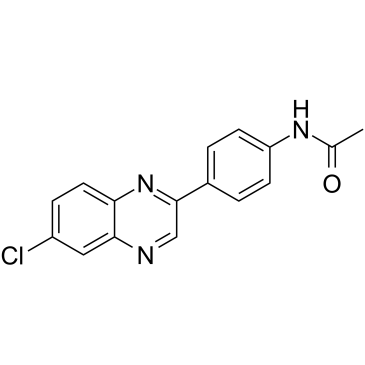Physicochemical Properties
| Molecular Formula | C16H12CLN3O |
| Molecular Weight | 297.7390 |
| Exact Mass | 297.066 |
| CAS # | 2412270-22-3 |
| PubChem CID | 146439211 |
| Appearance | Off-white to light yellow solid powder |
| LogP | 2.7 |
| Hydrogen Bond Donor Count | 1 |
| Hydrogen Bond Acceptor Count | 3 |
| Rotatable Bond Count | 2 |
| Heavy Atom Count | 21 |
| Complexity | 371 |
| Defined Atom Stereocenter Count | 0 |
| SMILES | ClC1C([H])=C([H])C2C(C=1[H])=NC([H])=C(C1C([H])=C([H])C(=C([H])C=1[H])N([H])C(C([H])([H])[H])=O)N=2 |
| InChi Key | ZQXMPDVGBWOTBY-UHFFFAOYSA-N |
| InChi Code | InChI=1S/C16H12ClN3O/c1-10(21)19-13-5-2-11(3-6-13)16-9-18-15-8-12(17)4-7-14(15)20-16/h2-9H,1H3,(H,19,21) |
| Chemical Name | N-[4-(6-chloroquinoxalin-2-yl)phenyl]acetamide |
| HS Tariff Code | 2934.99.9001 |
| Storage |
Powder-20°C 3 years 4°C 2 years In solvent -80°C 6 months -20°C 1 month Note: This product requires protection from light (avoid light exposure) during transportation and storage. |
| Shipping Condition | Room temperature (This product is stable at ambient temperature for a few days during ordinary shipping and time spent in Customs) |
Biological Activity
| ln Vitro | NIH 3T3 cells exhibit stable expression of the KFERQ-PS-Dendra reporter gene as a result of CA77.1's dose- and time-dependent activation of CMA (0-30 μM; 16 hours). The average of the fluorescence spots within each cell was used to calculate CMA activity [1]. LC3-II expression and autophagic flux in NIH 3T3 cells are unaffected by CA77.1 (20 μM; 6 hours) [1]. |
| ln Vivo | CA-77.1 (10 mg/kg; single dose; oral gavage) exhibits good pharmacokinetics and brain penetration. Cmax, AUClast, Tmax, and T1/2 are, in that order, 3534 ng/g, 8338 h*ng/g, 1 hour, and 1.89 hours [1]. In PS19 mice, previously reported hyperkinesia was normalized to control levels by CA77.1 (oral gavage; 30 mg/kg; 6 months). In the hippocampus, amygdala, and piriform cortex, it also decreased the quantity and percentage of neurons with pathogenic tau conformations. Vehicle-treated PS19 mice showed a decrease in the number of large Iba1-positive cells with rod-dystrophic morphology and an increase in microglia following CA77.1 treatment [1]. |
| Animal Protocol |
Animal/Disease Models: 9-month-old CTR or PS19 mice [1] Doses: 30 mg/kg Route of Administration: po (oral gavage); 30 mg/kg; 6-month Experimental Results: Behavior of frontotemporal dementia-related protein toxicity mouse model and neuropathology improved. |
| References |
[1]. Chaperone-mediated autophagy prevents collapse of the neuronal metastable proteome.Cell. 2021 May 13;184(10):2696-2714.e25. |
Solubility Data
| Solubility (In Vitro) |
DMSO : ~5 mg/mL (~16.79 mM) Ethanol : ~1 mg/mL (~3.36 mM) |
| Solubility (In Vivo) |
Solubility in Formulation 1: 2 mg/mL (6.72 mM) in 45% PEG300 +5% Tween-80 + 50% Saline (add these co-solvents sequentially from left to right, and one by one), suspension solution; with sonication. Preparation of saline: Dissolve 0.9 g of sodium chloride in 100 mL ddH₂ O to obtain a clear solution. (Please use freshly prepared in vivo formulations for optimal results.) |
| Preparing Stock Solutions | 1 mg | 5 mg | 10 mg | |
| 1 mM | 3.3586 mL | 16.7932 mL | 33.5864 mL | |
| 5 mM | 0.6717 mL | 3.3586 mL | 6.7173 mL | |
| 10 mM | 0.3359 mL | 1.6793 mL | 3.3586 mL |
